London Design Biennale 2025 — 7 Immersive Pavilions Reinterpreted as Lessons in Decor
We hit Somerset House for an exclusive preview of the exhibition's fifth edition, curated by Samuel Ross, and collected unexpected interior inspiration along the way
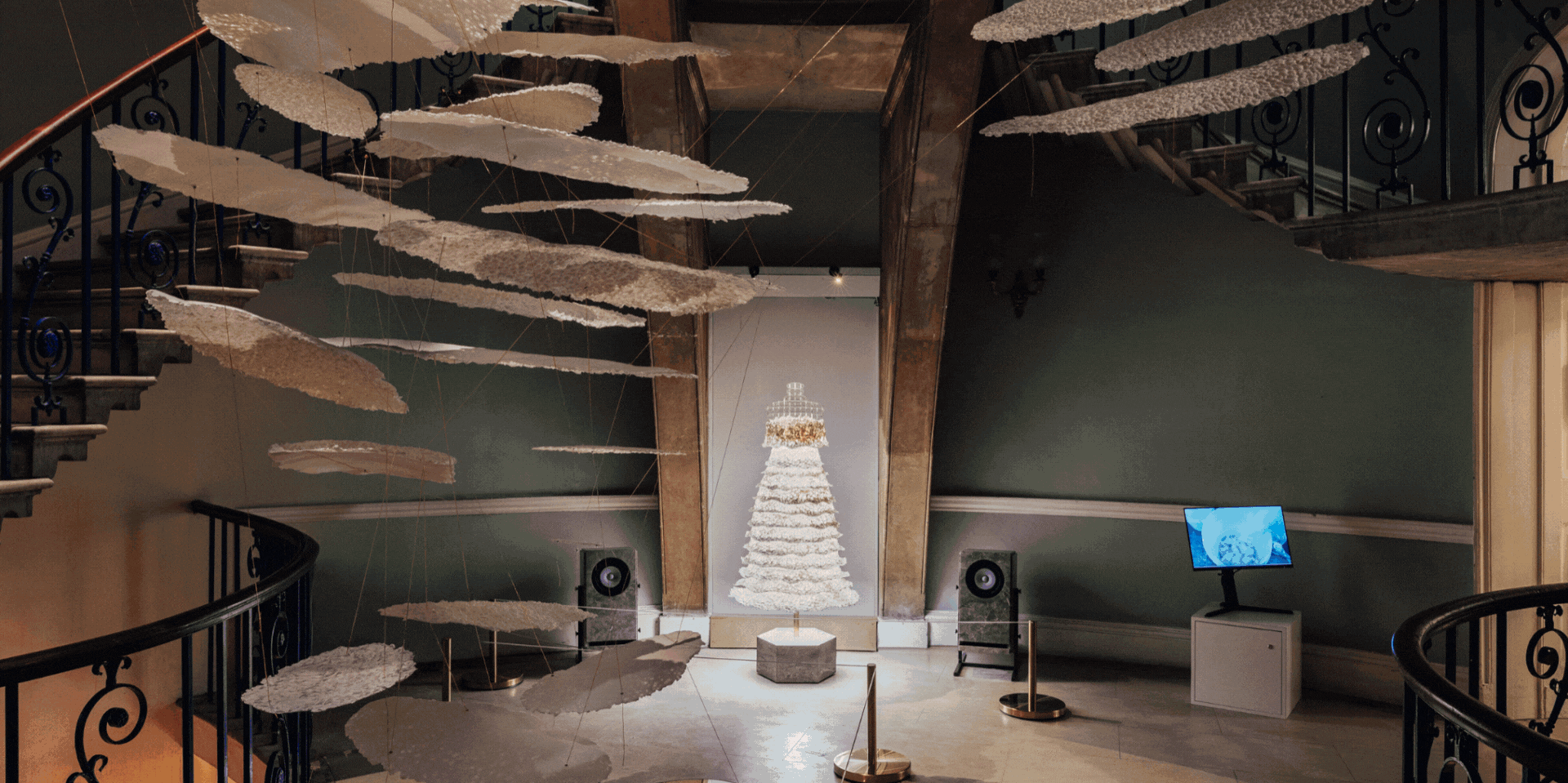

Is it just me, or has June in the British capital never felt busier? Between much-anticipated openings rethinking the role of museum collections, annual architecture festivals making the discipline as interactive as it's ever been, and more one-off design exhibitions to catch in London, this month is jam-packed with creative inspiration, starting from the latest iteration of the London Design Biennale. Inaugurated on June 5 (through June 29), the fifth edition of the acclaimed showcase, titled Surface Reflections, reunites over 40 countries from across the globe in a thought-provoking, cross-disciplinary presentation that, to quote its Artistic Director, Samuel Ross, strives to show "how design can be the great connector between industry, the political landscape, and meritocracy as a whole."
"Surface Reflections is an invitation to introspectively look at what we all have to offer with our unique allegories, context, and histories," the British fashion designer said during the speech that marked the unveiling of the London Design Biennale 2025. "It's about that distinction of self, but it's also about the connective tissue that links us all together. We go through the same processes and matters of life, whether that be eternal, internal, or external, matters of deep introspection or respite." Comprising 40 pavilions centered around the production of either specific nations, collective research projects, international collaborations, or standalone creatives, with contributions straddling the fields of design, culture, science, and technology, this year's curatorial program is, "at its core, a contemplation of the times that we're in — a call for us to consider our common interests, sense of self, and humanity", Ross said.
For us, it was an opportunity to learn directly from the designers who are shaping the future of the field about how their climate-friendly material innovations, reinvention of traditional craftsmanship techniques, and latest technological experimentation can weave their way into the home, too. Not just as meaningful decor additions, but as design principles that can inform the way we live moving forward — as my favorite projects from the London Design Biennale 2025 exemplify below.
1. Paper Clouds: Materiality in Empty Space, Japan — The Future is Weightless

Japan's pavilion, "Paper Clouds: Materiality in Empty Space", breathes new life into a centuries-old material to explore its architectural, fashion, and storytelling potential and shed light on sustainable approaches to design.
Taking over the cinematic Nelson Stair in Somerset House's West Wing, Paper Clouds: Materiality in Empty Space, Japan's participation in the London Design Biennale 2025, looks to the country's storied tradition of creating with Washi paper, derived from a blend of plant-fiber and wood pulps, to investigate its possible uses within the architecture and fashion space. A site-specific project by the University of Tokyo's SEKISUI HOUSE - KUMA LAB, curated by Clare Farrow, this whimsical, airy installation unfolds as a series of floating cloud-like structures that, hanging from the ceiling, captivate the viewer with their organically textural form. Amplified, like the sky projecting its color onto bodies of water, by the teardrop-shaped mirrors placed on the floor, it was activated by a stirring original piece of music, including live performances, by violinist and composer Midori Komachi, dressed for the occasion in a sculptural dress obtained from the same material.
The Take-Home Lesson
Pavilions like Paper Clouds: Materiality in Empty Space don't just look magical, as if offering a glimpse into another, delicately poetic world, but also demonstrate just how much more sustainable, and less detrimental to the environment, modern interior design, architecture, and couture can be when incorporating naturally sourced, ancient materials. A study in lightness, resilience, and the inner strength of Washi paper, the pavilion "is entirely recyclable and made with threads from traditional Japanese kimonos," curator Clare Farrow tells me. The music accompanying it captures the "actual sound that the medium makes when touching human skin". Played through visually unobtrusive, aesthetic speakers crafted from ancient stone by Mineral Sound, "it's a fusion of art forms that brings an experimental element to this 18th-century space," she adds.
2. Memory Grid, Oman — Heritage Doesn't Go; It Transforms
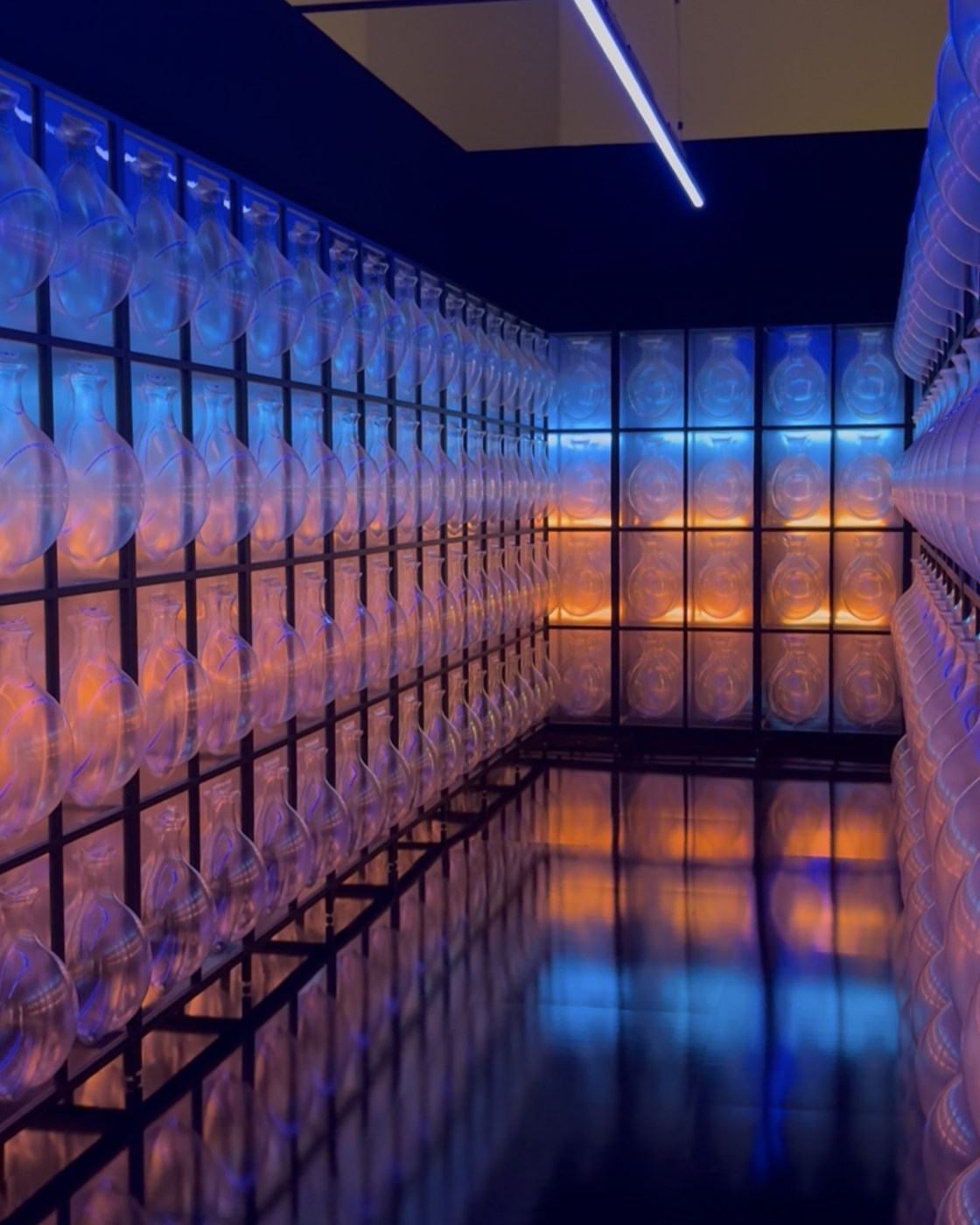
Informed by the ceramic heritage of Oman, and vessels' function as a carrier of goods, meaning, and culture, "Memory Grid" encourages reflection on the things we value most, from water to relationships and traditions.
Multiple dimensions coexist in architect Haitham Al-Busafi's pavilion for Oman, Memory Grid; at a moment, the blue neons above me make the corridor at its heart into the perfect setting for a sci-fi. The next, I am reminded of the primordial importance ceramic vessels have had for humans and the world as a whole, as carriers of primary goods, but also of meaning, heritage, and culture, since the dawn of time, as I inspect the transparent vases trapped in the installation's checkered structure. Already 5,000 years ago, "ancient civilizations used them as containers for storing whatever they deemed most precious — water, food, oil," Al-Busafi tells me. His Memory Grid does the same, just with our never-ending flow of data; "what we share constantly on social networks, day after day".
Rather than representing the data visually, he built the pavilion to immerse visitors in the modularity of a data center, the see-through body of each vase standing in for their incorporeality, their ephemeral essence, their fragility — and ours, in return. Created with actual vessels Al-Busafi 3D-scanned and used as molds, each fragment of Memory Grid, made from a hot plastic sheet, took its final shape through vacuum forming. Remembering how he once saw a fully intact ceramic vessel from around 300 BC while working at an archeological gallery in Oman, the designer asks: "should people still exist in 3,000 years' time, what would they find of us? Would there be anything left, or would things only exist in the digital realm?"
The Take-Home Lesson
My most immediate reaction to Oman's London Design Biennale 2025 pavilion was one: we shouldn't let go of traditional crafts, as those are the only ones with the potential to outlive us. Instead, we should allow them to take on new forms. Specifically, I was intrigued by Al-Busafi's 3D printer-assisted reinterpretation of pottery, and how, despite relying on different mediums than the original one, it still manages to convey ceramics' storied legacy and make it relevant to today's world.
3. URNA, Malta — Brutalist Design Captures the Beauty of Future, Present, and Past

Unfolding as a spectacular, large-scale spherical installation, "URNA" reimagines death and memorial using Maltese limestone by exploring the cultural shift since cremation was legalised in 2019".
I'll be honest, you'll have to see URNA, the Malta pavilion and Golden Medal winner at the 2025 London Design Biennale, in person to get a sense of the poetry captured in this project. A spherical, fascinating reconstituted limestone installation seemingly floating above a dark podium, complete with a short film screening in the space and a series of BTS printed matter catalogues, the project has just been announced as the most outstanding overall contribution to this year's exhibition. Created by a collaborative team of architects, designers, curators, and creative directors, it "speculates on a radical future for the adoption of cremation in Malta," they explain, one that reinvents the handling of human remains "as a culturally significant process". The idea is to integrate their dust into spheres like the one spotlighted here, each of which would become part of an alternative kind of burial site — a powerfully suggestive, utopian, quarry-like place where memory, heritage, sustainability, eco Brutalism, and transformation collide. As thought-provoking as forward-thinking, the commission, which draws from both ancient civilizations' sepulture practices and a futuristic approach to design, wants us to rethink the notion of death and the rituals around it through a surreally beautiful proposal that will make our departed loved ones an integral part of our everyday life.
The Take-Home Lesson
Although the greatest lesson one can take from URNA has been outlined above, there is more to be said about the opportunity that resides in regenerative design, and even more when applied to the decor world. Human remains aside, plenty are the creatives already repurposing other organic materials, from fungi and raw plant fibers to wheat, into functional projects that strike the balance between aesthetics and sustainability, one for all Mexico City-based Fernando Laposse, who recently featured in our review of London's hot new Latin American foodie hotspot, FONDA. Another take-home comes from URNA's brutalist essence — a reminder of how Brutalism, an architectural genre that's recently returned to the fore — continues to be associated with parallel realities and a desire to craft better futures for all.
4. SUR ANDINA, Argentina — Ancestral Practices Inform the Most Magical of Crafts
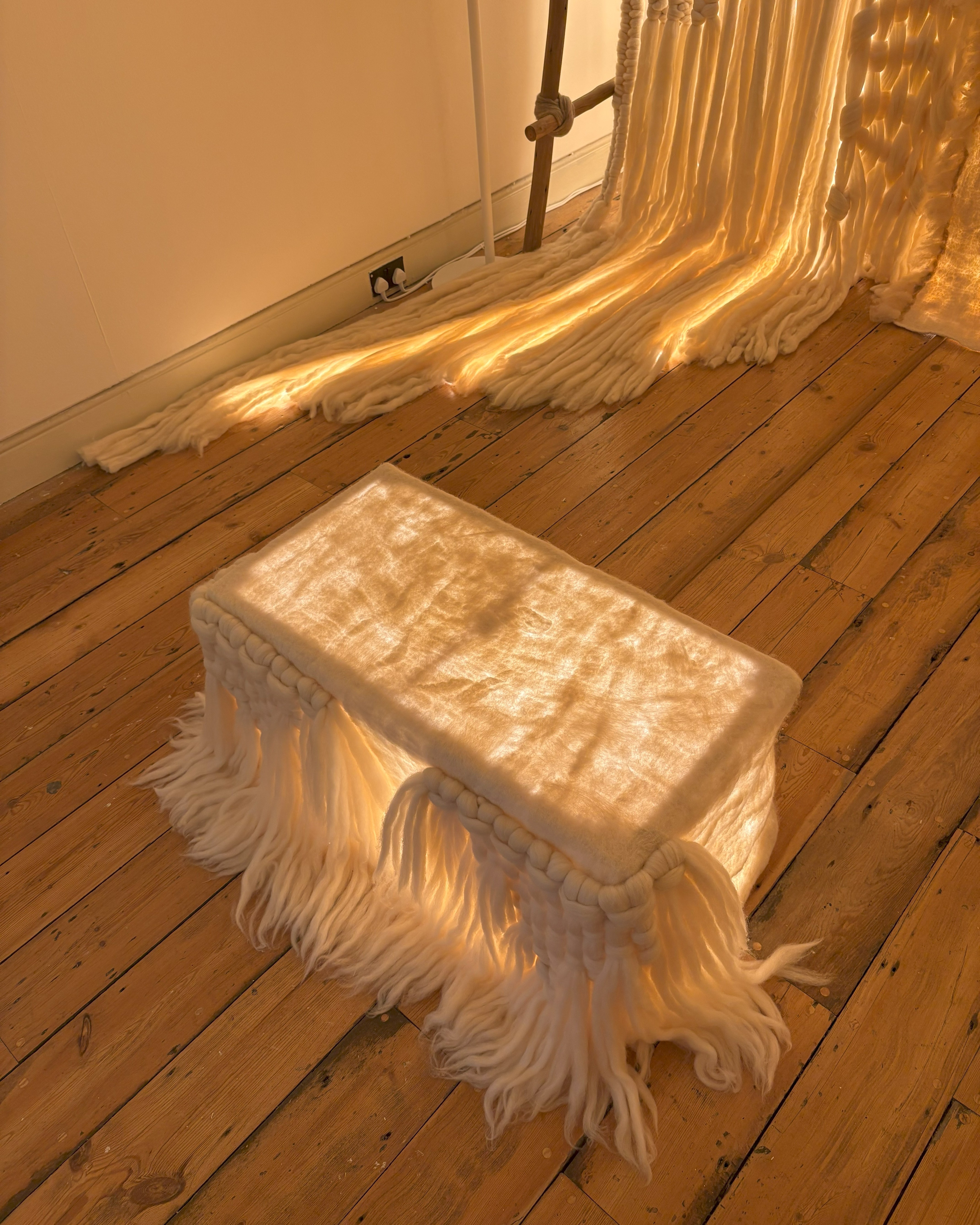
Fusing ancestral weaving techniques with evocative field recording and singing, "SUR ANDINA" immerses visitors in the vibrancy and folklore of the Andean world.
Putting the vibrancy of SUR ANDINA, the Argentinian presentation at the London Design Biennale 2025, into words will be hard, but I'll give it a go anyway. Wrapped around the walls of a small room in the East Wing of the showcase's location, looking at this installation feels like staring straight into the sun, as a giant, back-lit, loom-like structure stands glowing before you. A folklore-inspired collaboration between textile designer Cindy Lilen and sound artist Iliana Díaz López, this multisensory pavilion, pairing woven textiles and furniture with entrancing field recording, choral singing, and light, strives to evoke "the call of Mother Nature, the living pulse of the land, and the Andean world," the duo tells me. Combining multiple ancestral weaving techniques with a futuristic sound system and a mystical take on decor, it renders the beauty and wonder that lies in the outdoors.
The Take-Home Lesson
I had never considered how much specific textiles can alterate the way we perceive light, but as designer Cindy Lilen tells me while welcoming visitors to her London Design Biennale debut, "every type of wool makes for a completely different effect," and the ones she worked with collided to an otherworldly one. Obtained from locally sourced, indigenous, and regenerative natural fibers from Argentina's mountainous region of the Andes, SUR ANDINA not only leads the way in sustainable textile design, but also exemplifies the potential this medium can have in relation to sculptural, accent lighting. Plus, who wouldn't want that illuminated ottoman?
5. Notes to Humanity, Life Calling — Letting the Outdoors in Keeps Us Human

Life Calling's biophilic project, "Notes to Humanity" probes the continuum between the human and the natural, the natural and the technological, examining one question: "what does it mean to preserve your humanity in the Digital Age?"
Among the collective, non-country pavilions gathered in the fifth edition of the London Design Biennale, Life Calling's Notes to Humanity caught my eye for its essential set-up and powerful mission. Entering its room, situated in Somerset House's West Wing, feels like stepping into an ethereal library, dotted with beautiful green Banker's lamps, pale wood furniture, and thriving vegetation that infiltrates each corner of the room — from patches of musk to lush ficuses and ferns. Framed and hung on the left-hand side wall of the pavilion is a series of messages left by people from all walks of life, each addressing the same dilemma: "what does it mean to preserve your humanity in the Digital Age?" Rather than rushing off to see the next installation, here, visitors are invited to take a moment to think, stop, and express their vision of a human-friendly, incoming future.
The Take-Home Lesson
Any avid Livingetc reader will glance at Notes to Humanity and think the same thing: biophilic interior design. And while that was, largely, my very reaction given the green thumb feel of the installation, the initiative goes one step further than simply encouraging people to create domestic spaces that can foster a better way of life by incorporating plants, wellness-aiding textures, and colors into our domestic design. It prompts us to bring what we have inside out — whatever those worries, hopes, and preoccupations might be — get closer to ourselves, and to each other, all while allowing nature in. Call it indoor-outdoor living, just a little more brainy?
6. Wura, Global South — Artisanal Weaving Looks Back to Look Forward
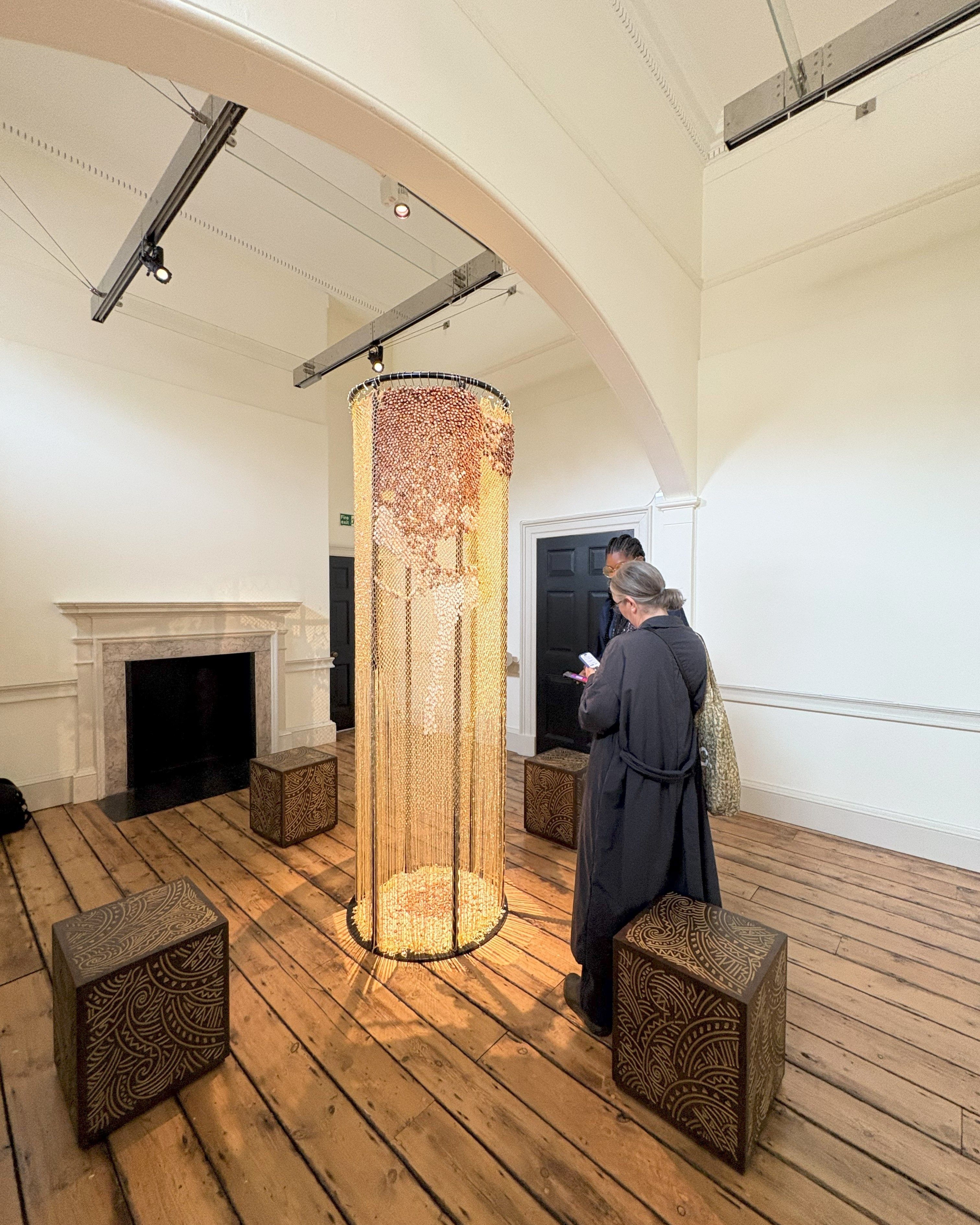
Translating to "precious" in Yoruba, "Wura" is "a sculptural tribute to the preciousness, resilience, and complexity of the Global South".
Wura, the Global South's contribution to the London Design Biennale 2025, sited at the very end of Somerset House's East Wing, enchants with its softly glowing quietness. Coming a couple of rooms after Saudi Arabia's tech-engineered, busy 'assembly line' exploration of water in the contemporary landscape, this golden-hued room instantly imbues you with a sense of calm. Created by lead artist and curator Danielle Alakija, Wura houses an inner lit standing sculpture framed by four square, wood-carved stools bearing handmade abstract motifs. The centerpiece, made from cowrie shells and gold chain — embodying the currencies of old Africa and today's one, respectively — speaks to the interlaced histories of trade, colonization, and cultural rebirth that have led the continent to the present day, and continue to inform its future. Translating to "precious" in Yoruba, the Wura pavilion captures the importance of acknowledging and reconciling with the past to move forward, without ever leaving our roots behind.
The Take-Home Lesson
Fashioned from shells, gold chain, and a cylindrical, wrought-iron structure, and hand-carved wood, the Global South's participation in the London Design Biennale 2025 is possibly the most interiors-worthy among the pavilions presented. While it's hard to abstract its message from its aesthetics, Alakija's work shows how traditional artisanal practices can be reinvented in a contemporary form that protects their history and resonance while making them even more resonant to the eye of today's viewers.
7. Human-Centred Design: Visuospace, Hong Kong — The Spaces We Inahbit Shape Our Well-Being
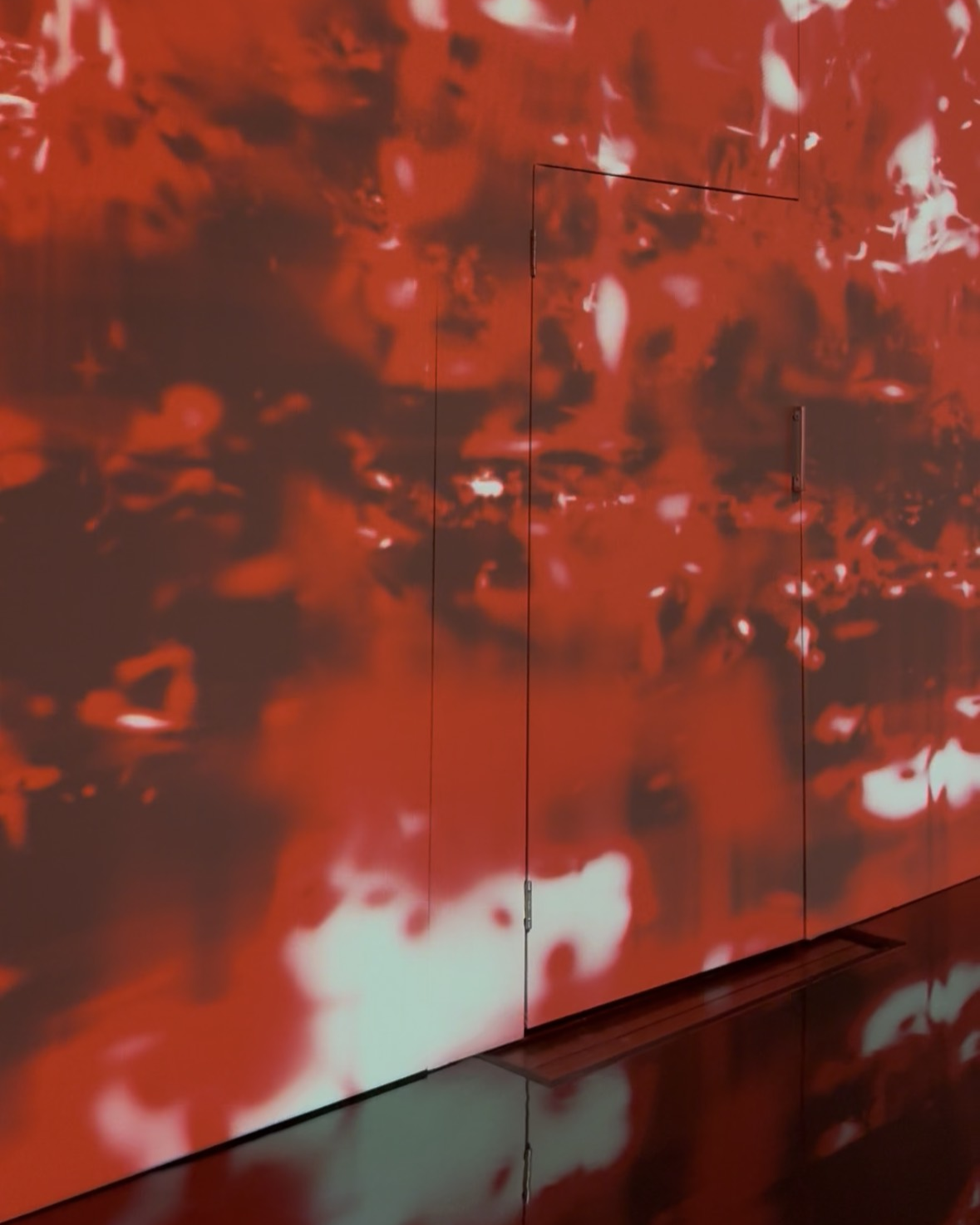
Translating emotional data relating to the feelings Hong Kongese residents feel whilst in their homes into a mesmerizing audiovisual installation, this pavilion "examines how the spaces we inhabit shape our well-being, asking a vital question: 'How can we live and build well?'"
Hong Kong's pavilion at the London Design Biennale 2025, Human-Centred Design: Visuospace, was one of the first ones I walked into during the event's press preview, and the one whose vision stuck with me the longest after leaving the building. A mesmerizing audiovisual installation at the intersection of art, design, and neuroscience, it will hypnotize you with its shape-shifting moving images, morphing from barely recognizable, abstract compositions into ultra-red renders of urban cityscapes and towering skyscrapers. Led by H.S. Choi, the project was developed by collecting emotional data from Hong Kong residents, monitoring the degree to which they felt happiness, sadness, anger, and frustration, the team behind it explains. The stats were then translated into an animated sequence that, assigning specific visual effects to each feeling experienced by the participants, maps the spectrum of Hong Kongese citizens' well-being into a neon-lit, captivating artwork.
The Take-Home Lesson
One of the most densely populated places on Earth, Hong Kong is known for its high-rise buildings, where residents live up to 200 meters above ground level. In Human-Centred Design: Visuospace, viewers are confronted with the way in which the spaces we inhabit shape our physical, mental, and emotional health through a spectacular audiovisual piece that digs into themes of identity, belonging, and alienation. Here, you won't just be able to discover how citizens living in lower-rise residential units compare to those housed in Hong Kong's tallest skyscrapers, but you'll also get to learn more about your own well-being, thanks to the opportunity of having your data collected via a headband on-site and shared with you within days.
The London Design Biennale 2025 is open at Somerset House, London, through June 29. Plan your visit.
The London Design Biennale 2025 couldn't, in any way, have landed at a more exciting moment for London's cultural community. What am I hinting at? Well, well, well. In case you missed it, the V&A, one of the world's leading museums, has just revealed its years-in-the-making, Stratford outpost, the Victoria & Albert East Storehouse. We visited it first-hand on its opening day last week to test drive it for you, and its 250,000-artifact collection is well worth a deep dive.
In other cultural news, Marina Tabassum's Serpentine Pavilion 2025 was inaugurated at the namesake Kensington Gardens gallery this Tuesday. A breathing, poetic installation with a tree at its heart, the large-scale enterprise captures how, by leaning into natural growth and transformation, "architecture can outlive time".

Gilda Bruno is Livingetc's Lifestyle Editor. Before joining the team, she worked as an Editorial Assistant on the print edition of AnOther Magazine and as a freelance Sub-Editor on the Life & Arts desk of the Financial Times. Between 2020 and today, Gilda's arts and culture writing has appeared in a number of books and publications including Apartamento’s Liguria: Recipes & Wanderings Along the Italian Riviera, Sam Wright’s debut monograph The City of the Sun, The British Journal of Photography, DAZED, Document Journal, Elephant, The Face, Family Style, Foam, Il Giornale dell’Arte, HUCK, Hunger, i-D, PAPER, Re-Edition, VICE, Vogue Italia, and WePresent.